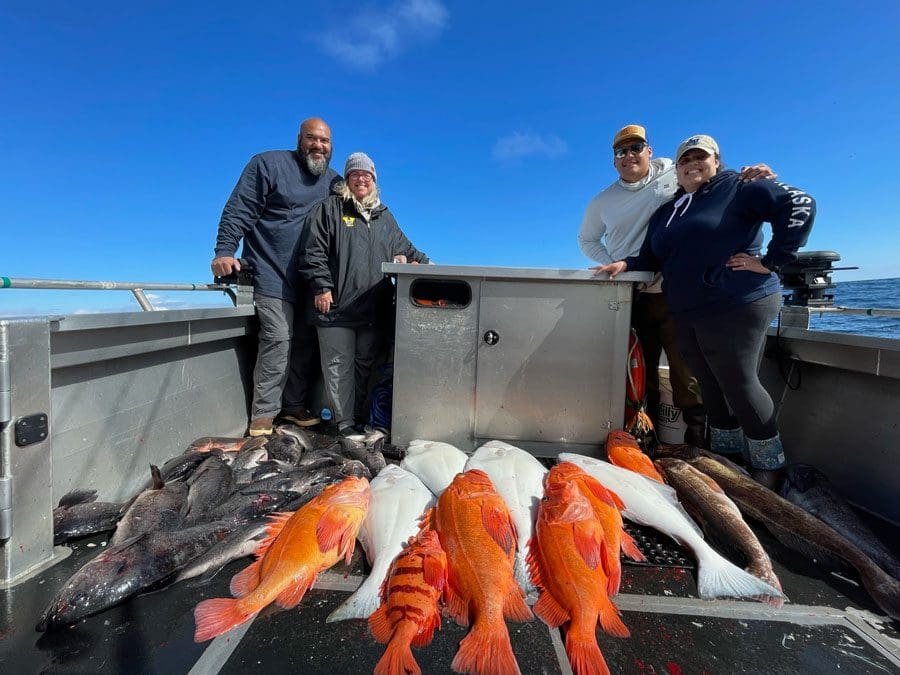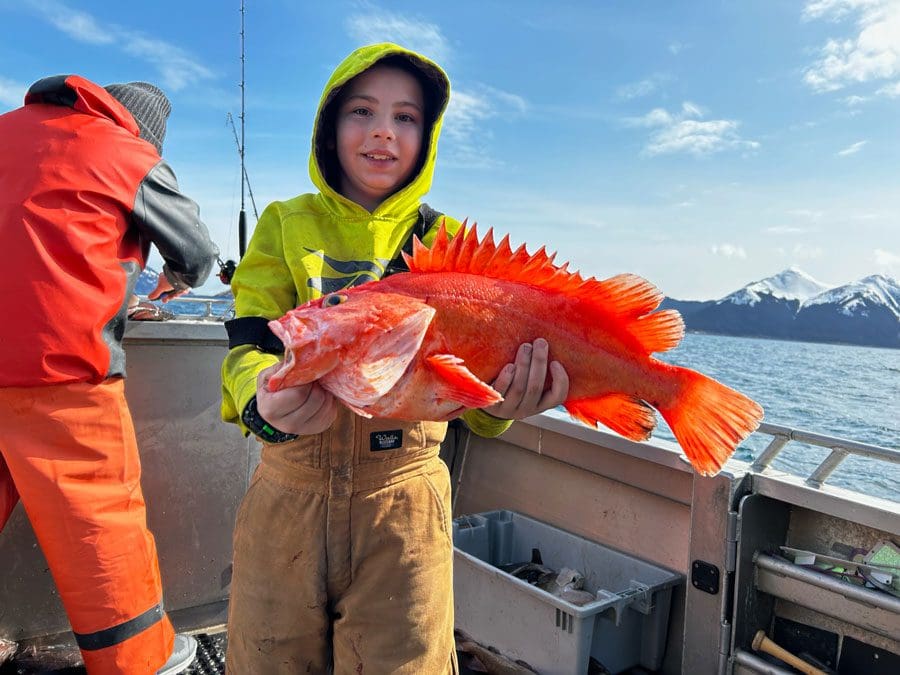If you love fast-paced biting action, then adding Alaska rockfish onto your halibut fishing charter is the perfect addition! Every year, thousands of anglers flock to these waters in search of this delicious seafood delicacy. The mild flavor and firm texture make it one of the most sought-after fish species in the region. There are several different varieties of Alaskan rockfish to catch too! Whether you’re looking for a tasty meal or an unforgettable adventure, fishing for rockfish in Alaska is sure to provide both!
What Are Alaska Rockfish
Alaska rockfish are an incredibly interesting species of fish. They are closely related to the Pacific Ocean perch and can be found in waters from Alaska down to California. Alaska rockfish are a popular seafood delicacy, known for their delicate flavor and firm texture. They have also been around since prehistoric times and can live up to 50 years! They grow slowly, reaching maturity at about 10 years old, but they can reach lengths of over two feet long and weigh up to 17 pounds!
Varieties + Fishing Techniques
We typically mooch for Alaska rockfish, making it a fast paced and exciting experience for anglers! Alaska is also home to 30 different varieties of rockfish species, each with its own unique characteristics. From the deep-dwelling black rockfish to the colorful yelloweye rockfish, there are plenty of options for anglers looking for an unforgettable fishing experience.




Pelagic vs. Non-Pelagic | Alaska Rockfish
Alaska is home to both species of rockfish- pelagic and non-pelagic. So what's the difference you ask? Pelagic fish and non-pelagic fish are two distinct types of species that inhabit the oceans. Pelagic fish, also known as oceanic or open water fish, live in the upper layers of the ocean and are typically found near the surface where there is plenty of sunlight. Non-pelagic fish, meanwhile, inhabit deeper waters along continental shelves and seafloors. While both types have adapted to their respective environments over time, there are some key differences between them which make each unique in its own way.
Below are the two main species of rockfish that are targeted on daily charters from Homer, Alaska.
Non-Pelagic: The Yelloweye Rockfish ... Aka "Alaska's Goldfish"
The yelloweye rockfish is a species of fish found in the waters off Alaska. It can be identified by its bright yellow eyes, white underside and reddish-brown upper body. This colorful fish grows up to two feet long and can weigh up to 17 pounds! Yelloweye rockfish are highly sought after due to their delicate flavor and firm texture when cooked properly. Due to being a speciality specie of the rockfish family (non-pelagic), anglers fishing on the Kenai Peninsula are regulated to one yelloweye per day.
Pelagic: Black Rockfish... Aka "Blackies"
Like yelloweye rockfish, black rockfish is found in the waters off Alaska. It is easily distinguishable by its dark brown, almost black color and can grow up to two feet long and weigh up to 17 pounds. Blackies are highly sought after due to being considered pelagic and anglers being able to keep a larger bag limit per day.
So what are the key differences? | Alaska Rockfish
As mentioned above, the main difference between pelagic fish and non-pelagic fish lies in their habitat. Pelagic fish inhabit the upper layers of the ocean, usually near the surface where there is plenty of sunlight. This allows them to access more sources of food, such as zooplankton and small crustaceans, as well as have greater opportunity for migration. Non-pelagic fish, meanwhile, inhabit deeper waters along continental shelves and seafloors. These fishes do not have access to the same amount of sunlight or diversity in their diet and are typically limited in their movement due to the depths they live in.
Are there differences in sizes?
Lastly, pelagic fish tend to be smaller than non-pelagic specimens due to their need for better maneuverability when swimming in open water. As a result, they also have thinner body shapes making them more aerodynamic and enabling faster swimming speeds. Non-pelagic species tend to be bulkier with thicker bodies that allow them to move more slowly through the deep ocean waters while still having enough power to hunt prey and avoid predators.
Let's talk behavior...
In terms of behavior, pelagic fish are typically more schooling than non-pelagic species as they rely on each other for protection from predators in such an exposed environment. Non-pelagic fishes can also form shoals, but are less likely to do so due to their depths providing greater safety from larger predators. Also, pelagic species will often follow seasonal migrations up or down depending on temperature or other environmental factors whereas non-pelagic fish will remain relatively static over time within their depths throughout the year.
The Angler’s Guide to Kenai River Fishing
Alaska's Kenai River fishing is widely known as an angler's paradise! Mostly …
Alaska Halibut Fishing | An Unforgettable Adventure
Are you looking for an exciting fishing experience in the beautiful state …
Alaska Rockfish | Things To Know
If you love fast-paced biting action, then adding Alaska rockfish onto your …
Bear Viewing Alaska | Things to Do
Our Favorite Meals | Alaska Rockfish
Alaska rockfish is a delicious and nutritious seafood delicacy that can be cooked in many different ways. From baking, grilling, steaming, or frying - the possibilities are endless when it comes to preparing this delectable fish! Baking is one of the most popular methods as it helps retain moisture and flavor while also keeping the fish nice and crispy. Grilling over an open flame will give you a smoky flavor that pairs perfectly with your favorite sides. Steaming is another great option for those looking to keep their meals light and healthy. Lastly, frying allows for maximum crispiness on the outside while preserving tenderness within – making it a great choice for any occasion! Whichever method you choose, cooking Alaska rockfish will provide you with an unforgettable culinary experience!
Below are our household favorite recipes:


0 Comments